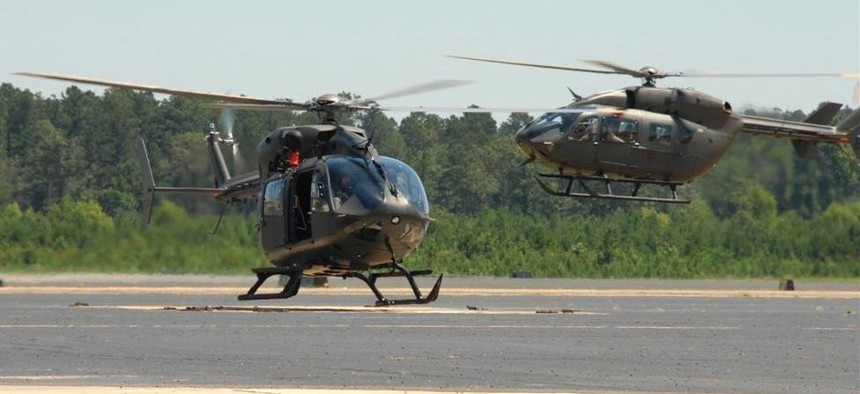
Two Louisiana National Guard UH-72 Lakota helicopters. Stephanie J. Cross/U.S. Army
Army Details Future Controversial Helicopter Swap With the National Guard
Apache, Blackhawk, Kiowa and Lakota helicopters are all on the block for major realignment. By Marcus Weisgerber
The U.S. Army is moving ahead with a controversial plan to shift helicopters between the active-duty and National Guard and buying new aircraft without competition, despite ongoing litigation trying to block it.
Getting rid of military equipment is never easy. Over decades, planes, tanks and ships become engrained in military bases throughout the country, building vocal and powerful supporters in local communities, Congress and the defense industry. It makes any attempt to retire or move equipment to other bases difficult if not impossible.
The Army’s plans to shift Apache attack helicopters from the National Guard to the active-duty in exchange for Blackhawks, retire all of its Bell OH-58 Kiowas and buy Airbus Lakota helicopters for training without holding a competition for new aircraft has struck nerves within all of those constituencies.
The National Guard is upset it will lose combat aircraft to utility aircraft. And helicopter makers – specifically Bell and AgustaWestland – say they could sell the Army single-engine helicopter trainers for a fraction of the price of 100 twin-engine Lakota. AgustaWestland has even taken rare the step of suing the Army in federal claims court to block the sale. But the Army is still moving forward with the reorganization plan.
Twelve Lakotas are scheduled to arrive at Fort Rucker, in Alabama, “by the end of the quarter,” said Col. John Lindsay, the director of aviation on the Army staff at the Pentagon, Thursday at the Center for Strategic and International Studies. By 2018, the Army plans to have 187 Lakotas dedicated to training about 1,000 student pilots each year.
The Army National Guard currently uses the Lakota only for stateside missions, such as medical evacuation and search and rescue. In the training role, the helicopter would replace the Bell TH-67 Creek. Army instructor pilots who previously schooled students in TH-67 helicopters have been developing a training program for the Lakota, Lindsay said.
“We expect that will get to the point where we’re capable of going though a program of instruction from start to finish in the summer of 2015,” Lindsay said. “That first class is scheduled to begin” between October and December 2015.
Army leaders say that by buying the Lakota, a helicopter already in its inventory, and retiring the Kiowa, they will save billion of dollars over the long term. The decision has been driven by defense budget cuts.
“To bring another aircraft in is just not economical, feasible or affordable,” Col. Walter Rugen, chief of Army aviation force development at the Pentagon, said at the same event Thursday.
Army officials say moving Apaches to the active ranks would allow them to deploy more often and that the Blackhawk is better suited for stateside National Guard missions, such as search and rescue and disaster relief.
Congress, in the recently passed 2015 National Defense Authorization Act, asked the Government Accountability Office to assess the Army’s helicopter restructure plans in a report due by March 1.




